Bulletin – July 2004 Measuring Housing Prices
- Download 120KB
This article discusses some of the issues involved in measuring housing prices and assesses what the latest data available are indicating about the movements in house and apartment prices in Australia so far in 2004. As such, it is an update of the data provided in the May Statement on Monetary Policy. At times such as the present, where the issue is whether a turning point has been reached, it is essential to look at as wide a range of price indicators as possible, even though each one may have deficiencies or be subject to future revision. While the data are not good enough to make definitive judgements, our broad conclusion is that, for Australia as a whole, prices for houses and apartments have fallen so far in 2004, and that this result is mainly due to developments in the two largest cities.
Issues in Measuring Housing Prices
Before looking at the recent data, it is useful to review some of the difficulties in measuring housing prices, and to see how these affect the various indicators that are available. There are at least three problems that make it difficult to obtain an accurate and timely reading on housing price developments in Australia.
(a) Timeliness
The most important issue has to do with the lack of timeliness of data, which is a product of various institutional factors in the housing market. The market for housing is unlike many financial and commodity markets, which have centralised systems for trading and settlement of transactions, and where good price data are available essentially instantly. Instead, the market for housing is completely decentralised. Furthermore, whereas financial and commodity exchanges require the reporting of all transactions, the market for housing has no similar mandatory reporting requirement at the time the transaction is agreed.
Because of the decentralised nature of the market, measures of housing prices typically use data from the various state government land titles offices, which are generally recorded some time after settlement. This is usually several months after the transaction was agreed via the exchange of contracts.[1] Processing lags typically mean this information is not available for purchase by third parties until another week or two later, but potentially significantly longer delays can occur if aspects of the transaction need to be checked. Thus, at any point in time, much of the latest available housing price information relates to prices that were actually determined several months earlier. In addition, settlement and recording lags can vary significantly across transactions so that data relating to contracts signed in any particular period do not all become available at the same time, but will be spread out over time.[2]
(b) Compositional Changes
Only a small fraction of the total stock of housing is traded in any period, so measures of transactions prices are dependent on the mix of properties sold in each period. Given the heterogeneous nature of the housing stock, changes in the average price of property transactions from one period to the next will reflect changes in the types of properties changing hands, as well as pure price changes. For example, if transactions in one period consist mostly of larger houses or houses in more expensive suburbs, average prices will appear to have increased, though the price for a given type of house may not have changed.
(c) Quality Improvement
A third problem with housing price data is that the quality of the national housing stock has improved substantially over time. Newly built houses are much larger now than they were a decade or two ago, and the existing housing stock is constantly being improved through renovations and extensions. These improvements will be reflected in prices, although they are really quality changes, not price changes. In principle, the problems of compositional change and quality improvements can be addressed using hedonic price indices, which control for the changing characteristics of the stock, but as yet there are no hedonic indices available for Australia. While quality changes distort movements in average housing prices over long periods, they are unlikely to be a significant factor in short-term movements, which are relevant when attempting to identify turning points.
Existing Measures of Housing Prices
The problems discussed above are manifested in different ways in the various existing series for Australian housing prices, which suggests that users of each series need to be aware of these potential shortcomings. In practice, the problems do not generally result in existing measures of housing prices that are widely at variance with each other, and over reasonably long periods, such as the six years shown in Graph 1, they tend to show a reasonably similar story. However, at turning points the differences between the series become more apparent.
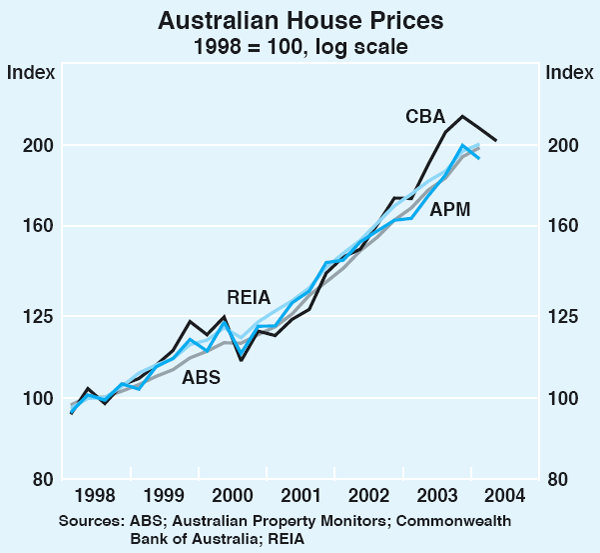
The main characteristics of the most widely used series are outlined below. They are discussed in order of the length of time they have been produced, starting with the oldest. Appendix Table A1 provides a summary of the attributes of the series.
Real Estate Institute of Australia (REIA). The REIA has provided quarterly capital city data since the late 1970s expressed as median prices. This is the longest standing data series and is based on series computed by the various state REIs. For most capitals, the REIA uses data from the state land titles offices. In the case of Melbourne, the longer average settlement period in Victoria means that a sufficiently comprehensive sample would not be available by the cut-off date, so the REIA instead uses data from a survey of real estate agents by the Real Estate Institute of Victoria. The timing convention for the REIA series for most states is that the quarterly indices relate to transactions that are settled in the particular quarter, but the series for Brisbane and Melbourne are exceptions in that the series refer to transactions contracted in the reference quarter. Although some of the state REIs release state-level data more quickly, the REIA releases data for each quarter around 10 weeks after the end of the quarter, by which time most of the relevant sales will have been recorded.
While the REIA measures that use data from state governments are quite comprehensive, this comes at the expense of timeliness. The combination of settlement, lodgement, processing and publication lags means that the settlement-dated housing price data series for the March quarter published in June probably contain as many sales from the December quarter as from the March quarter. As settlement typically occurs one to two months or more after contracts are exchanged, price data that are referenced by settlement date will lag true developments in the market, especially around turning points.
Commonwealth Bank of Australia (CBA). In principle, there are two ways to collect price data at or near the time that contracts are agreed on. One option would be for real estate agents to report sales prices once the contract is agreed. Another would be for lenders to report prices once they have agreed to provide funds for a purchase.[3] The data collected by the CBA on lending to owner-occupiers for new purchases is an illustration of the latter approach. Median prices from the CBA are available for the capital cities going back to 1984, and have been published over a long period by the Housing Industry Association (HIA). A major advantage of the CBA data is that they refer to transactions at some point between contract and settlement, and hence are more timely than settlement-dated figures. In addition, they become available shortly after the end of the reference period, and are not subject to revision.[4] A disadvantage is that although they come from a large national lender, the sample may not be completely representative of all transactions and might have changed over time.
ABS indices of house prices. The ABS produces quarterly indices of detached house prices in capital cities, going back to 1986. The ABS indices are based on essentially the same raw data as the series produced by the REIA, and also refer mostly to transactions settled in the reference quarter. An important difference is that the ABS makes an attempt to partly control for compositional change in the type of properties being sold, by stratifying sales by broad geographic region, with average price changes in each region weighted together to give the overall price change for a city. However, this is only a limited solution, because it does not fully control for compositional change within a region, or from changes in the average quality of houses being sold in different periods. The ABS indices are typically released about nine weeks after the end of the reference quarter and so are among the last of the data series to be released. This delayed timing is designed to ensure that the indices capture most of the sales settled in that quarter; although some additional sales are reported after the ABS cut-off date, revisions of the data are not made, presumably because the additional data would not have a material impact on the overall average. The ABS price indices show a smoother pattern than the other series.
Residex ‘repeat sales’ indices. Repeat sales indices, available for Brisbane, Melbourne and Sydney, are produced by Residex, a property research firm, based on data received from state land titles offices. These indices go back to 1978 and attempt to abstract from compositional change in housing turnover by taking into account only price changes between successive sales of the same property. Residex uses statistical techniques to estimate a general housing price index from changes in prices of individual properties between consecutive sales. Hence, unlike other data series, the Residex indices are specifically designed to minimise the impacts of compositional change. The repeat sales methodology is likely to produce measures that come closest to capturing pure price changes, although – like other indices – they cannot abstract from quality changes associated with renovations and extensions, which may account for a significant part of the price gain between repeat sales.
The main disadvantage of a repeat sales methodology is that the resultant indices are subject to substantial revision. The estimation methodology is such that the estimated growth rate in general housing prices in any period is determined not only by the prices of properties sold in that period, but also by prices of properties for which consecutive transactions occurred either side of that period. The most recent periods are subject to particularly large revision, as the properties that actually changed hands in a period are a relatively small proportion of the total number of sale prices that will eventually affect the index in that period. This revision problem will be exacerbated by the problem facing all series based on state government data, that the settlement and reporting lags mean that sales from a particular period become available only gradually, so initial estimates for a period will be based on an incomplete sample.
Australian Property Monitors (APM). The data produced by APM, another property research firm, provide data for seven capitals, based on data that they obtain several times a month from the relevant state land titles offices as properties are settled. APM then compiles these data based on the date of the contract rather than the settlement, so the median price series measure price developments at the time that prices were agreed on, rather than when transactions were settled.[5] Price indices measured at the time of contract exchange conceptually provide a more accurate indicator of the true dynamics of the housing market than do settlement-referenced measures, such as those produced by the REIA and ABS. However, as noted above, price data for contracts exchanged in a particular period become available only gradually. Hence the benefits of timeliness of contract-based measures are offset, to some extent, by the fact that the initial sample for any period may be quite small. As the Bank noted in its May 2004 Statement on Monetary Policy, the settlement and reporting lags in the raw data mean that the initial estimates of median prices from APM are subject to progressive revision as a more complete sample becomes available. This issue is likely to be most important in the March quarter of each year, given that the month of January tends to be characterised by both a low volume of transactions and a mix of transactions that is skewed slightly to lower-value properties.
Recent Developments in Housing Prices
The May 2004 Statement on Monetary Policy used early data for house and apartment prices for the March quarter to advance a preliminary judgement that prices had fallen in that quarter. Since then, the measures produced by the ABS and REIA have become available, and the measures produced by APM and Residex have been revised. The most up-to-date figures for house prices are shown in Table 1.[6]
| ABS | APM | CBA | REIA | Residex | |
|---|---|---|---|---|---|
| Sydney | 3.5 | −1.0 | −2.9 | 4.0 | 0.0 |
| Melbourne | −1.3 | −9.5 | −5.0 | −0.8 | 0.1 |
| Brisbane | 6.2 | 0.7 | −2.0 | −1.4 | −0.3 |
| Adelaide | 3.0 | 3.1 | −1.8 | 1.3 | |
| Perth | 1.2 | 2.0 | −0.5 | 2.8 | |
| Canberra | 4.2 | 1.8 | −10.7 | 11.7 | |
| Australia | 2.5 | −2.4 | −3.2 | 2.0 | |
|
Sources: ABS; APM; CBA; REIA; Residex |
|||||
The data present a mixed picture, but the overall trend is that the measures using prices at or close to contract date (the APM and CBA measures) show that for Australia as a whole, prices for houses fell in the March quarter (although the APM figures show smaller falls than in the earlier estimates). This national movement was mainly due to developments in the two largest cities. The other two nationwide measures (from the ABS and REIA) do not show a fall in nationwide average prices in the March quarter, but as they are mainly based on settlement-dated figures, they would be expected to lag true developments. The ABS has noted that its settlement-based price data will lag true developments in the market, especially around turning points.
The various measures show some variation for each city. For Melbourne, four of the five measures show a fall in prices in the March quarter. For Sydney, only two of the five series show falls, but the measures showing increases use settlement-dated figures. For Brisbane, three of the five measures show a fall in prices, with only the ABS settlement-dated measure showing a significant increase. For the other capitals, most data suggest price rises, but modest ones compared with the strong increases seen until late 2003.
Comprehensive data for the June quarter will not be available for some time, but it is possible to get some preliminary guide to developments in the quarter from the CBA and APM data, both of which are available on a monthly basis. Graphs 2, 3, 4 and 5 show quarterly data from these providers with the quarterly observations plotted in the middle month of the quarter, in bold. In addition, the graphs show monthly data, in finer lines, seasonally adjusted by the RBA. The CBA data are shown through to June, while the APM quarterly data are shown through to March and monthly data are shown only where the sample of transactions appears large enough to be indicative of price movements. As was noted above, because of settlement and processing delays, the APM data are subject to revision as more data become available.
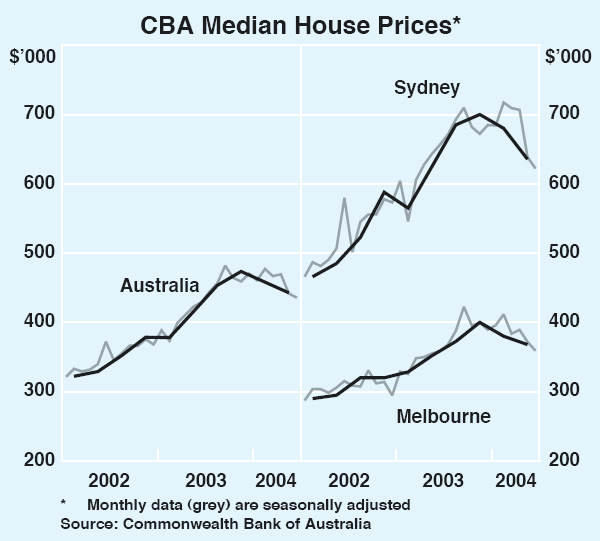
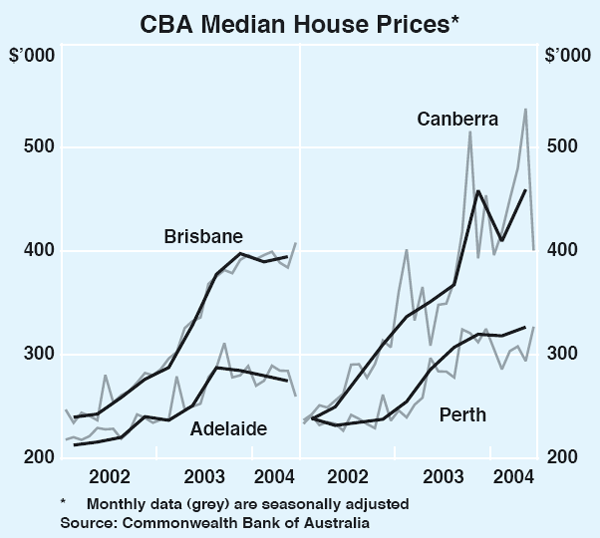
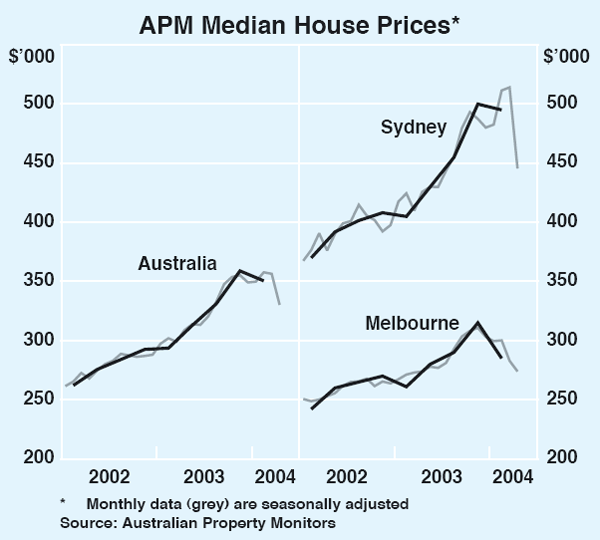
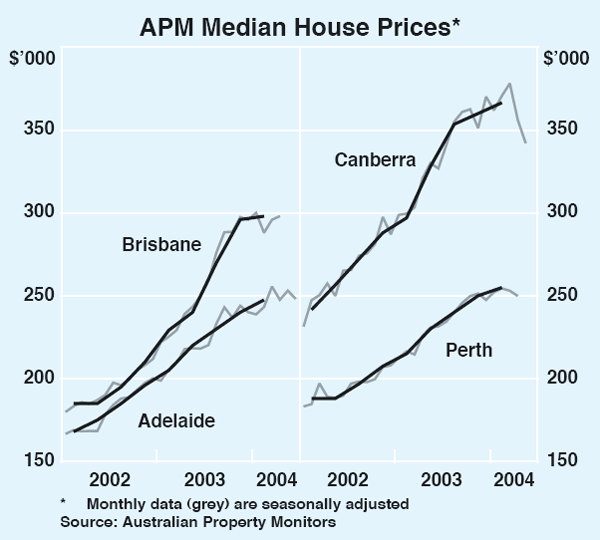
The data that are available so far for the June quarter provide broad support for the conclusions drawn above for the March quarter. If the falls in many of the measures of house prices in March had been due to measurement error or statistical volatility, the falls could well have been reversed in the June quarter. However, there is little evidence of this: if anything the data available to date for the June quarter suggest further weakness in that quarter. In particular, the quarterly and monthly data from the CBA suggest a further fall in nationwide average house prices, driven by falls in Sydney and Melbourne. In addition, the latest estimates from APM for median prices in April, May or June (depending on sample size) suggest that prices in all capitals were lower than they had been three months earlier.
The revised March quarter data for apartments are shown in Table 2. Based on these data, two of the three nationwide average measures show falls in prices in the March quarter. In addition, three of the four measures for Sydney and Melbourne show falls. Other capitals appear to have seen price increases (the large fall in the CBA series for Perth is probably an aberration due to a small sample).
| APM | CBA | REIA | Residex | |
|---|---|---|---|---|
| Sydney | −0.7 | −5.4 | 1.4 | −1.0 |
| Melbourne | −6.6 | −10.2 | −2.1 | 0.3 |
| Brisbane | 4.5 | 7.9 | 6.0 | 3.5 |
| Adelaide | 4.0 | 2.0 | 2.8 | |
| Perth | 3.4 | −23.0 | 2.7 | |
| Australia | −1.2 | −6.6 | 1.1 | |
|
Sources: APM; CBA; REIA; Residex |
||||
The more recent figures from the CBA and APM for Sydney and Melbourne do not provide a clear signal (Graphs 6 and 7). The CBA quarterly series for June partially retraced the falls in March, but did not bring prices back to their December levels. The CBA monthly series rose and then fell within the June quarter, whereas the APM series are available only up to April.
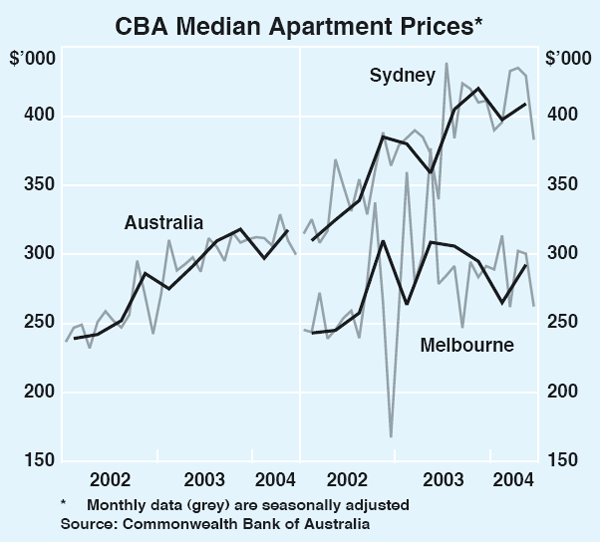
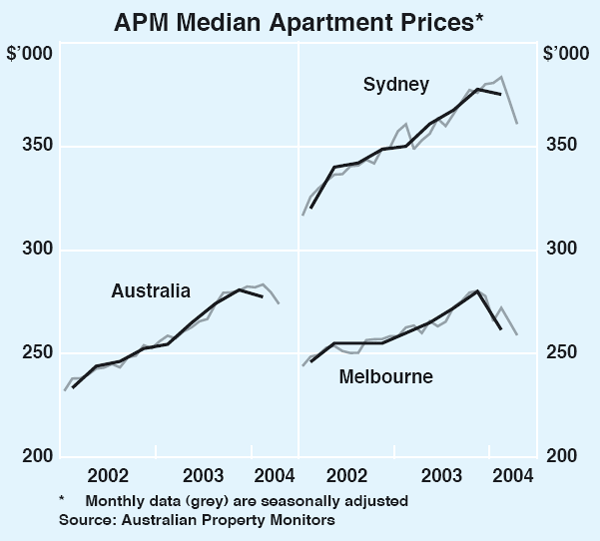
Conclusion
Overall, updated measures of house and apartment prices in the March quarter and the highly preliminary data for the June quarter provide additional evidence to support the conclusion that nationwide housing prices have fallen since the December quarter of 2003. For Australia as a whole, prices for houses and apartments appear to have fallen in 2004, with this result mainly due to developments in the two largest cities. The picture in the other capitals is more mixed, but broadly appears to be one of prices having risen moderately or remained fairly flat over the past six months or so.
However, any judgements about developments in housing prices are subject to the caveat that timely and comprehensive price data are not available. Indeed, the recent debate over developments in housing prices has drawn attention to the difficulties in ascertaining exactly what is happening in this market. The Bank has recently been working with the ABS and Australian Treasury to explore possible approaches to improving the timeliness, comprehensiveness and quality of nationwide housing price data. Housing represents around 65 per cent of household wealth and around 85 per cent of household borrowing, and property-related revenues (mostly from residential property) account for over 35 per cent of total state government own-revenues. Given the macroeconomic importance of housing, there is a strong public policy case for improved data in this area.
| REIA | CBA | ABS | Residex | APM | |
|---|---|---|---|---|---|
| Data available from | September quarter 1978 for houses, March quarter 1980 for apartments (later for smaller capitals) | March quarter 1984 | September quarter 1986 | December quarter 1978 | March quarter 1993 (March quarter 1995 for monthly Melbourne data) |
| Frequency | Quarterly(a) | Monthly & quarterly | Quarterly | Monthly & quarterly | Monthly & quarterly |
| Measure type | Median price | Median price | Price index | Repeat sales price index | Median price |
| Dwelling types | Houses; apartments (including other attached dwellings) | Houses; apartments (including other attached dwellings) | Detached houses | Houses (including other attached dwellings); apartments | Houses (including other attached dwellings); apartments |
| Geographic coverage | All state/territory capitals | All state/territory capitals excluding Darwin for houses; excluding Canberra, Darwin and Hobart for apartments | All state/territory capitals | Brisbane, Melbourne & Sydney | All state/territory capitals excluding Hobart |
| Release date & revision policy | Around 10 weeks after end of reference quarter (data for some capitals available earlier from state REIs), data not revised | Data available almost immediately after the reference quarter, no revisions necessary | Around 9 weeks after end of reference quarter, data not revised | Regularly updated | Regularly updated |
| Reference date | Settlement (except Brisbane and Melbourne, where contract exchange) | Final approval of loan to CBA customer (usually later than contract exchange, but earlier than settlement) | Settlement (except Melbourne and Perth, where contract exchange) | Settlement | Contract exchange |
| Data sources | Land titles offices (except Hobart and Melbourne, for which data are sourced from surveys of real estate agents) | CBA loan book | Land titles offices (except Melbourne and Perth, for which data are sourced from Real Estate Institutes' surveys of real estate agents) | Land titles offices | Land titles offices |
| Adjustment for compositional changes | None | None | Geographically stratified (for smaller capitals, data also stratified by number of bedrooms) | Repeat sales index | None |
|
(a) Data for houses are monthly up to June quarter 1998, quarterly thereafter. Sources: ABS; APM; CBA; REIA; Residex |
|||||
Footnotes
Victoria is the most extreme case in this regard, where the average period between contract and settlement is around 90 days (although the gap for some transactions may be much longer), and lodgement of information can take place up to 28 days after settlement. [1]
Of course auction price data from various commercial data providers are available on a much more timely basis than the settlement data from state titles offices. However, these data do not include all auction sales: some agents may decline to provide auction results. More importantly, auctions account for only a limited part of the market; comprehensive data indicate that in recent years, the auction share is around 25 per cent in Melbourne, 12 per cent in Sydney and much less in other capitals. [2]
Of course neither method would be comprehensive. The lender approach would not capture those sales where the purchaser does not borrow from a lending institution. The real estate agent approach would not capture the smaller fraction of sales that do not involve an agent. Both approaches would presumably also include the small proportion of sales that fall through prior to settlement. [3]
The CBA has also recently publicised a new ‘property value guide’. It is based on a combination of transactions prices for new purchases, and valuations for other loan applications for renovations, home equity and consumer loans, etc. The CBA describes the data as an indicative guide only. Since a substantial part of the guide is based on borrowers' self-reported property valuations, it will be subject to the numerous problems associated with valuations. Thus, the guide cannot be considered a price index in the usual sense of capturing prices determined in the market place. In addition, with only one year of history available, the properties and quality of the guide cannot be assessed. [4]
The exception on this point is Adelaide, where prices are allocated according to ‘transfer date’, which may be either the contract or settlement date. [5]
The figures in the table and in subsequent charts are based on data available as of 5 July. For those measures where no Australia-wide average is provided, weighted averages are calculated by the RBA. [6]